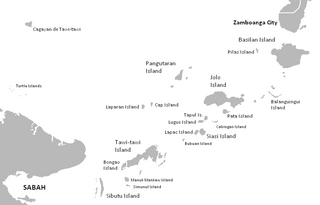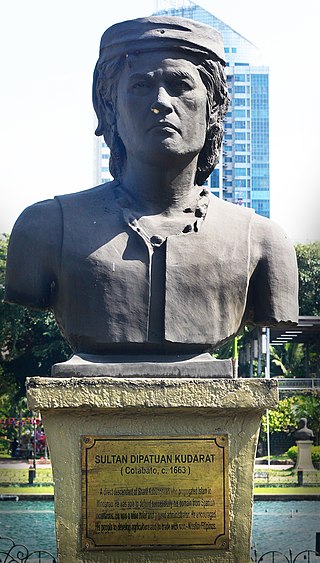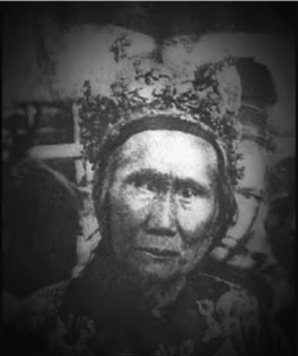
The Sulu Archipelago is a chain of islands in the Pacific Ocean, in the southwestern Philippines. The archipelago forms the northern limit of the Celebes Sea and southern limit of the Sulu Sea. The Sulu Archipelago islands are within the Mindanao island group, consisting of the provinces of Basilan, Sulu, and Tawi-Tawi; hence the archipelago is sometimes referred to as Basulta, derived from the first syllables of the three provinces.

Tawi-Tawi, officially the Province of Tawi-Tawi, is an island province in the Philippines located in the Bangsamoro Autonomous Region in Muslim Mindanao (BARMM). The capital of Tawi-Tawi is Bongao.

The Autonomous Region in Muslim Mindanao was an autonomous region of the Philippines, located in the Mindanao island group of the Philippines, that consisted of five predominantly Muslim provinces: Basilan, Lanao del Sur, Maguindanao, Sulu, and Tawi-Tawi. It was the only region that had its own government. The region's de facto seat of government was Cotabato City, although this self-governing city was outside its jurisdiction.

The Sultanate of Sulu was a Muslim state that ruled the Sulu Archipelago, parts of Mindanao and certain portions of Palawan in today's Philippines, alongside parts of present-day Sabah, North and East Kalimantan in north-eastern Borneo.

The Tausūg or Suluk, are an ethnic group of the Philippines and Malaysia. A small population can also be found in the northern part of North Kalimantan, Indonesia. The Tausūg are part of the wider political identity of Muslims of Mindanao, Sulu and Palawan. Most of the Tausūg have converted into the religion of Islam whose members are now more known as the Moro group, who constitute the third largest ethnic group of Mindanao, Sulu and Palawan. The Tausugs originally had an independent state known as the Sultanate of Sulu, which once exercised sovereignty over the present day provinces of Basilan, Palawan, Sulu, Tawi-Tawi, Zamboanga City, North Kalimantan and the eastern part of the Malaysian state of Sabah.

Islam was the first-recorded monotheistic religion in the Philippines. Islam reached the Philippines in the 14th century with the arrival of Muslim traders from the Persian Gulf, southern India, and their followers from several sultanates in the wider Malay Archipelago. The first missionaries then followed in the late 14th and early 15th centuries. They facilitated the formation of sultanates and conquests in mainland Mindanao and Sulu. Those who converted to Islam came to be known as the Moros, with Muslim conquest reaching as far as Tondo that was later supplanted by Bruneian Empire vassal-state of Maynila.

Butig, officially the Municipality of Butig, is a 6th class municipality in the province of Lanao del Sur, Philippines. According to the 2020 census, it has a population of 22,768 people.

The Moro people or Bangsamoro people are the 13 Muslim-majority ethnolinguistic Austronesian groups of Mindanao, Sulu, and Palawan, native to the region known as the Bangsamoro. As Muslim-majority ethnic groups, they form the largest non-Christian population in the Philippines, and comprise about 5% of the country's total population, or 5 million people.

The Iranun are a Moro ethnic group native to Mindanao, Philippines (the west coast of Sabah, Malaysia, There are Iranun communities in Indonesia especially Riau Islands, Sumatra, Kalimantan whom adopted the Melayu Timur identity and language but still used the Iranun at the same time.

The Maguindanao people are an Austronesian ethnic group from the Philippines. The Maguindanaon are part of wider political identity of Muslims of Mindanao, Sulu and Palawan known as Moro, who constitute the third largest ethnic group of Mindanao, Sulu and Palawan. The Maguindanaons are constitute the sixth largest Filipino ethnic group and are known for their distinguished in the realm of visual art. Historically, they have been renowned as metalworkers, producing the wavy-bladed keris ceremonial swords and other weapons, as well as gongs. The Maguindanaos historically had an independent Sultanate known as Sultanate of Maguindanao which comprises Maguindanao del Norte, Maguindanao del Sur, Zamboanga Peninsula, Davao Region and Soccsksargen.The name "Maguindanao" itself was corrupted by Spanish sources into "Mindanao", which became the name for the entire island of Mindanao.

The Sultanate of Maguindanao was a sultanate that ruled parts of the island of Mindanao, in the southern Philippines, especially in modern-day Maguindanao province, Soccsksargen, Zamboanga Peninsula and Davao Region. Its known historical influence stretches from the peninsula of Zamboanga to the bay of Sarangani. During the era of European colonization, the Sultanate maintained friendly relations with British and Dutch traders.

Muhammad Dipatuan Kudarat (1581–1671) was the 7th Sultan of Maguindanao from 1619 to 1671. During his reign, he successfully fought off Spanish invasions and halted the spread of Catholicism on the island of Mindanao, much like the other Muslim rulers in the southern Philippines. He was a direct descendant of Shariff Kabungsuwan, a Malay-Arab noble from Johor who brought Islam to Mindanao between the 13th and 14th centuries. The Soccsksargen province of Sultan Kudarat is named after him, as is the municipality of Sultan Kudarat, Maguindanao, where his descendants, who bear the rank of Datu, are current political leaders.

Basilan is an island province of the Philippines. It is the largest and northernmost of the major islands of the Sulu Archipelago and is located just off the southern coast of Zamboanga Peninsula. Its capital is Lamitan. Basilan is home to three main ethnic groups, the indigenous Yakans, and the later-arriving Tausugs and Chavacanos. The Yakans and Tausugs are predominantly Muslim, while the Chavacanos are mainly Christian. There are also a number of smaller groups.
Muhammad Azim ud-Din I was Sultan of Sulu from 1735 to 1748, and again from 1764 until his abdication in 1774. He was briefly converted to Catholicism under the name Fernando until he returned to Sulu and reverted to Islam, dying as a Muslim.
Sultan Muwallil Wasit, is the 9th Sultan of Sulu and was also known as Rajah Bongsu I. His birth name was Pangiran Shahbandar Maharajalela, and was the youngest son of former Sultan of Brunei Muhammad Hassan. He reigned in Sulu after his uncle, Sultan Batara Shah Tengah died without an heir. He was most likely sent to Sulu to end dynastic troubles there, as he was begot of the marriage of Batara Tengah's Sister, and the Sultan of Brunei. On his coming to Sulu in 1609, he was brought by his father Sultan Muhammad Hassan brought along with his royal symbol's called as "Pulau Janggi" and "Sepong Janggi". This royal symbol was a symbol of brotherhood between the Sultanate of Sulu and the Sultanate of Brunei and as a royal proof that Raja Bongsu-I really belonged to the royal family of Brunei.

The Spanish–Moro conflict was a series of battles in the Philippines lasting over several centuries. It began during the Spanish Era and lasted until the Spanish–American War, when Spain finally began to subjugate the Moro people after centuries of poor attempts to do so. Spain ultimately conquered portions of the Mindanao and Jolo islands and turned the Sultanate of Sulu into a protectorate, establishing geographic dominance over the region until the Spanish-American War. Moro resistance continued.
Sultan Batara Shah Tengah was the 8th Sultan of Sulu. He reigned from 1596 to 1608. He was the son of the previous Sultan Muhammad ul-Halim, also known as Pangiran Buddiman.

Datu Utto was also known as Sultan Anwarud-din Utto or Sultan Utto Anwaruddin, was the 18th Sultan of Buayan, one of the minor sultanates of Mindanao. As a military leader he distinguished himself in many battles against the Spanish.

Dapitan Kingdom is the term used by local historians of Bohol to refer to the Dauis–Mansasa polity in the modern city of Tagbilaran and Panglao Island. The volume of artifacts unearthed in the sites of Dauis and Mansasa may have inspired the creation of the legend of "Dapitan Kingdom" through piecing together the oral legends of the Eskaya people and historical events such as the Ternatan raid of Bohol and the migration of Boholanos under Datu Pagbuaya to Dapitan.















